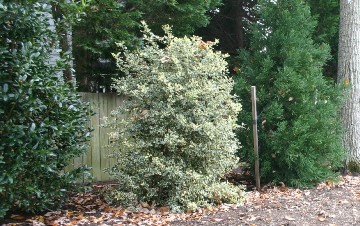| Back to Back Issues Page |
 |
|
Landscape Update Fall/Holiday 2013 December 11, 2013 |
'Tis the Season for Hollies!
Most Virginia landscapes aren't complete without hollies. Their evergreen leaves and berries add needed color in the winter as well as food for wildlife. Hollies are tough being drought, heat and insect resistant. Most varieties are also deer resistant. In Virginia, it is such a staple in the landscape because of its strong appearance and ability to give the landscape a sturdy structure. What a great backdrop it makes for flowering shrubs, perennials, bulbs and annuals. Varieties with striking variegated foliage as seen in the photograph can be easily used as a focal point. Their white variegation especially stands out when used beside solid green plants making them appear like they are dusted with snow. Their versatility is one of their best traits because varieties are available from dwarf size to large trees. The red berry laden foliage is used for decorating for the holidays with its traditional red and green colors. Here are a few not so common varieties that will add something special and unique to your landscape. Christmas Jewel Holly (Ilex x 'HL10-90' Christmas Jewel® PP 14477 ) and Santa's Delight Holly (Ilex aquifolium 'Sadezam') are both plants that mature at an 8-10' height. This makes them ideal to use off a corner of your house where they have room to grow or as a privacy screen. The Christmas Jewel Holly has a rich green leaf with an abundance of red berries in the fall. Santa's Delight Holly has a gorgeous variegated leaf that has a cream edge that turns pink in the fall. It is also a heavy berrying variety, but must have a male English holly close by to berry. (Only Female hollies berry, but some do not have to be cross pollinated. For example, the familiar Nellie R. Stevens Holly berries without a pollinator whereas the female native American holly needs to be pollinated by a male plant to produce berries). Golden Girl Holly (Ilex x meserveae 'Golden Girl') and Honey Maid Holly (Ilex x 'Honey Maid' P.P.# 12060) are two slow growing English holly varieties that are easily maintained as foundation plants and hedges. Because of their slow growth rate, they can be kept at a height shorter than the anticipated height at maturity. Particularly nice is Golden Girl's unique golden yellow berry set against a rich dark green leaf. Honey Maid Holly is a variegated, red berrying holly growing more compact than other variegated ones. Dwarf hollies are used in small spaces, in front of taller shrubs or under low windows. Scallywag Holly (Ilex x meservae 'MonNieves' P.P.# 21,941) and Little Rascal Holly (Ilex x 'Mondo') are low growers that have foliage that has a burgundy cast in the winter. They are both males that do not produce berries, but can be used as a pollinator for other female English hollies. Little Rascal has a mounding growth habit whereas Scallywag Holly is more upright.
The 2013 Holly of the year is Longstalk Holly (Ilex pedunculosa). This plant grows slowly to about 20'. Unlike most berrying hollies, its leaf does not have spines making it easy to touch and prune. It has abundant red berries in the winter, but does need a male pollinator. There is a variety with variegated foliage. This plant does a great job creating privacy, as a focal point or as part of a naturalistic planting. Hollies do shed old leaves regularly, so I don't use them around swimming pools or other places where people walk bare foot. I no longer recommend Chinese Holly or Dwarf Chinese Holly. Their spines are so long and stiff, they are hard to prune without getting hurt. If you step on one of their leaves, they puncture your foot. Thankfully, the plant hybridizers have developed hollies with softer spines that bend when touched. Hollies are a welcome sight in the winter woods among the bare branches of the large deciduous trees. Any of the taller growing varieties like Fine Line with its yellow leaf margins and Red Beauty with its abundance of berries can be a welcome addition and thrive in these conditions. Birds love the berries too! Get a jump on the spring by planning your landscape projects in the winter! Designing, constructing, and planting projects can all be done now. You'll be ready to enjoy the outdoors when the warm spring weather arrives.
May you all have a Happy Holiday and Prosperous New Year!
Landesign has been making outdoor spaces beautiful places for 32 years. I appreciate your repeat business and referrals! Please
contact me
to inquire about landscape design services.
Nancy Dransfield
|
| Back to Back Issues Page |
